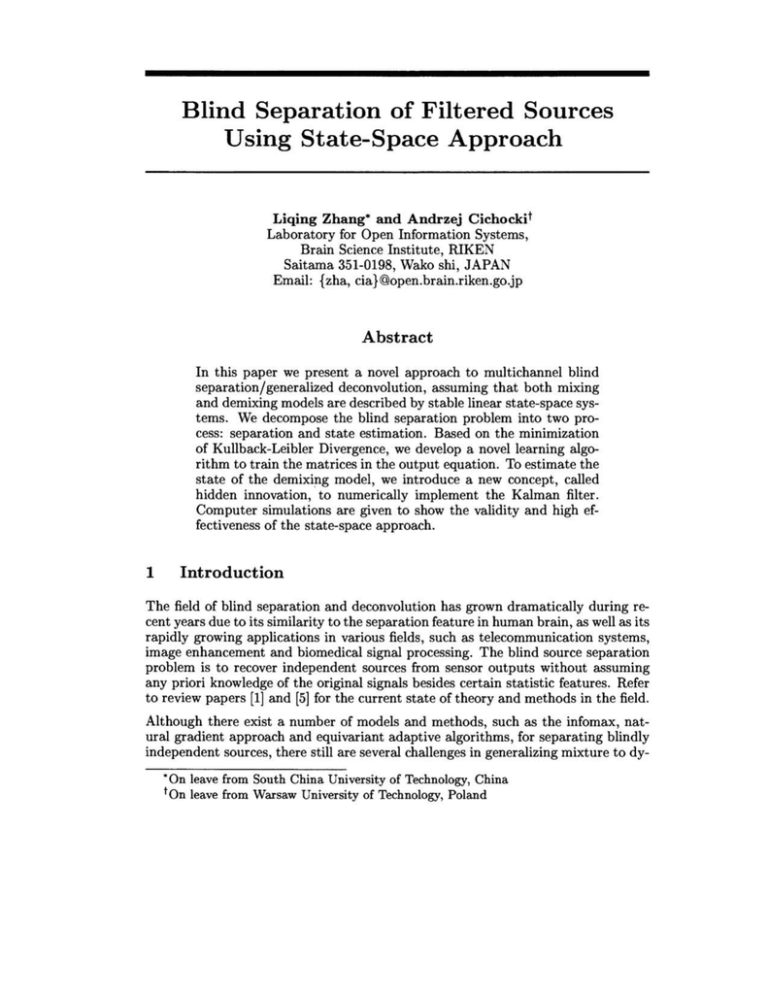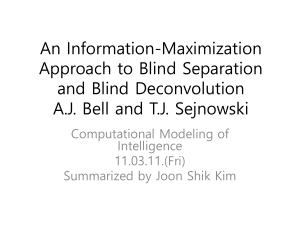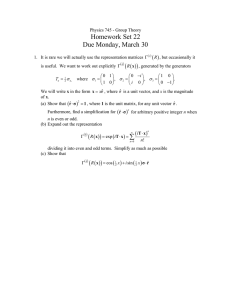Blind Separation of Filtered Sources Using State
advertisement

Blind Separation of Filtered Sources
Using State-Space Approach
Liqing Zhang· and Andrzej Cichocki t
Laboratory for Open Information Systems,
Brain Science Institute, RIKEN
Saitama 351-0198, Wako shi, JAPAN
Email: {zha.cia}@open.brain.riken.go.jp
Abstract
In this paper we present a novel approach to multichannel blind
separation/generalized deconvolution, assuming that both mixing
and demixing models are described by stable linear state-space systems. We decompose the blind separation problem into two process: separation and state estimation. Based on the minimization
of Kullback-Leibler Divergence, we develop a novel learning algorithm to train the matrices in the output equation. To estimate the
state of the demixing model, we introduce a new concept, called
hidden innovation, to numerically implement the Kalman filter.
Computer simulations are given to show the validity and high effectiveness of the state-space approach.
1
Introd uction
The field of blind separation and deconvolution has grown dramatically during recent years due to its similarity to the separation feature in human brain, as well as its
rapidly growing applications in various fields, such as telecommunication systems,
image enhancement and biomedical signal processing. The blind source separation
problem is to recover independent sources from sensor outputs without assuming
any priori knowledge of the original signals besides certain statistic features. Refer
to review papers [lJ and [5J for the current state of theory and methods in the field.
Although there exist a number of models and methods, such as the infomax, natural gradient approach and equivariant adaptive algorithms, for separating blindly
independent sources, there still are several challenges in generalizing mixture to dy·On leave from South China University of Technology, China
tan leave from Warsaw University of Technology, Poland
Blind Separation ofFiltered Sources
649
namic and nonlinear systems, as well as in developing more rigorous and effective
algorithms with general convergence.[1-9], [11-13]
The state-space description of systems is a new model for blind separation and
deconvolution[9,12]. There are several reasons why we use linear state-space systems
as blind deconvolution models. Although transfer function models are equivalent
to the state-space ones, it is difficult to exploit any common features that may
be present in the real dynamic systems. The main advantage of the state space
description for blind deconvolution is that it not only gives the internal description
of a system, but there are various equivalent types of state-space realizations for a
system, such as balanced realization and observable canonical forms. In particular
it is known how to parameterize some specific classes of models which are of interest
in applications. Also it is much easy to tackle the stability problem of state-space
systems using the Kalman Filter. Moreover, the state-space model enables much
more general description than standard finite impulse response (FIR) convolutive
filtering. All known filtering (dynamic) models, like AR, MA, ARMA, ARMAX and
Gamma filterings, could also be considered as special cases of flexible state-space
models.
2
Formulation of Problem
Assume that the source signals are a stationary zero-mean i.i.d processes and mutually statistically independent. Let s(t) = (SI (t),"', sn(t)) be an unknown vector of
independent Li.d. sources. Suppose that the mixing model is described by a stable
linear state discrete-time system
(1)
x(k + 1)
Ax(k) + Bs(k) + Lep(k),
(2)
u(k)
Cx(k) + Ds(k) + 6(k),
where x E RT is the state vector of system, s(k) E R n is the vector of source signals
and u(k) E R m is the vector of sensor signals. A, B, C and D are the mixing
matrices of the state space model with consistent dimensions. ep(k) is the process
noise and 6(k) is sensor noise of the mixing system. If we ignore the noise terms
in the mixing model, its transfer function matrix is described by a m x n matrix of
the form
H(z) = C(zI - A)-l B + D,
(3)
where Z-1 is a delay operator.
We formulate the blind separation problem as a task to recover original signals
from observations u(t) without prior knowledge on the source signals and the state
space matrices [A, B, C, D] besides certain statistic features of source signals. We
propose that the demixing model here is another linear state-space system, which
is described as follows, (see Fig. 1)
x(k + 1) = Ax(k) + Bu(k) + LeR(k),
(4)
y(k) = Cx(k) + DU(k),
(5)
where the input u(k) of the demixing model is just the output (sensor signals)
of the mixing model and the eR(k) is the reference model noise. A, B, C and
D are the demixing matrices of consistent dimensions. In general, the matrices
W = [A, B, C, D, L] are parameters to be determined in learning process.
For simplicity, we do not consider, at this moment, the noise terms both in
the mixing and demixing models. The transfer function of the demixing model
is W(z) = C(zI - A)-1 B + D. The output y(k) is designed to recover the source
signals in the following sense
y(k) = W(z)H(z)s(k) = PA(z)s(k),
(6)
L. Zhang and A. Cichocki
650
u(k)
Figure 1: General state-space model for blind deconvolution
where P is any permutation matrix and A(z) is a diagonal matrix with Aiz-Ti
in diagonal entry (i,i), here Ai is a nonzero constant and Ti is any nonnegative
integer. It is easy to see that the linear state space model mixture is an extension
of instantaneous mixture. When both the matrices A, B, C in the mixing model
and A, B, C in the demixing model are null matrices, the problem is simplified to
standard leA problem [1-8].
The question here is whether exist matrices [A, B, C, D] in the demixing model (4)
and (5), such that its transfer function W(z) satisfies (6). It is proven [12] that if
the matrix D in the mixing model is of full rank, rank(D) = n, then there exist
matrices [A, B, C, D], such that the output signal y of state-space system (4) and
(5) recovers the independent source signal 8 in the sense of (6).
3
Learning Algorithm
Assume that p(y, W),Pi(Yi, W) are the joint probability density function of y and
marginal pdf of Yi, (i = 1" . " n) respectively. We employ the mutual information
of the output signals, which measures the mutual independence of the output signals
Yi(k), as a risk function [1,2]
n
l(W) = -H(y, W)
+L
H(Yi, W),
(7)
i=l
where
H(y, W) = -
J
p(y, W)logp(y, W)dy, H(Yi, W) = -
J
Pi(Yi, W)logpi(Yi, W)dYi.
In this paper we do not directly develop learning algorithms to update all parameters W = [A, B, C, D] in demixing model. We separate the blind deconvolution
problem into two procedures: separation and state-estimation. In the separation
procedure we develop a novel learning algorithm, using a new search direction, to
update the matrices C and D in output equation (5). Then we define a hidden
innovation of the output and use Kalman filter to estimate the state vector x(k).
For simplicity we suppose that the matrix D in the demixing model (5) is nonsingular n x n matrix. From the risk function (7), we can obtain a cost function for
on line learning
1
l(y, W) = -2logdet(DT D) -
n
L logpi(Yi, W),
i=l
(8)
651
Blind Separation of Filtered Sources
where det(D T D) is the determinant of symmetric positive definite matrix DT D.
For the gradient of I with respect to W, we calculate the total differential dl of
l(y, W) when we takes a differential dW on W
dl(y, W) = l(y, W
+ dW) -l(y, W).
(9)
Following Amari's derivation for natural gradient methods [1-3], we have
dl(y, W) = -tr(dDD- I ) + cpT(y)dy,
(10)
where tr is the trace of a matrix and cp(y) is a vector of nonlinear activation
functions
CPi(Yi) = - dlogpi(Yi) = _P~(Yi).
(11)
dYi
Pi(Yi)
Taking the derivative on equation (5), we have following approximation
dy = dCx(k)
+ dDu(k).
(12)
On the other hand, from (5), we have
u(k) = D- I (y(k) - Cx(k))
(13)
Substituting (13) into (12), we obtain
dy = (dC - dDD-IC)x
+ dDD-ly.
(14)
In order to improve the computing efficiency of learning algorithms, we introduce a
new search direction
= dC-dDD-IC ,
(15)
dX 2
=
dDD- I .
(16)
Then the total differential dl can be expressed by
(17)
dl = -tr(dX 2) + cpT(y)(dXIX + dX2Y)'
It is easy to obtain the derivatives of the cost function I with respect to matrices
Xl and X 2 as
cp(y(k))XT(k),
(18)
cp(y(k))yT (k) - I.
(19)
From (15) and (16), we derive a novel learning algorithm to update matrices C and
D.
~C(k) = 'T] (-cp(y(k))xT(k) + (I - cp(y(k))yT(k))C(k)) ,
(20)
~D(k)
= 'T] (I - cp(y(k))yT(k)) D(k).
(21)
The equilibrium points of the learning algorithm satisfy the following equations
E[cp(y(k))XT(k)] = 0,
(22)
E
[I -
cp(y(k))yT (k)] = O.
(23)
This means that separated signals y could achieve as mutually independent as
possible if the nonlinear activation function cp(y) are,suitably chosen and the state
vector x(k) is well estimated. From (20) and (21), we see that the natural gradient
learning algorithm [2] is covered as a special case of the learning algorithm when
the mixture is simplified to instantaneous case.
The above derived learning algorithm enable to solve the blind separation problem
under assumption that state matrices A and B are known or designed appropriately.
In the next section instead of adjusting state matrices A and B directly, we propose
new approaches how to estimate state vector x.
L. Zhang and A. Cichocki
652
4
State Estimator
From output equation (5), it is observed that if we can accurately estimate the state
vector x(k) of the system, then we can separate mixed signals using the learning
algorithm (20) and (21).
4.1
Kalman Filter
The Kalman filter is a useful technique to estimate the state vector in state-space
models. The function of the Kalman Filter is to generate on line the state estimate
of the state x(k). The Kalman filter dynamics are given as follows
x(k
+ 1) =
Ax(k)
+ BU(k) + Kr(k) + eR(k),
(24)
where K is the Kalman filter gain matrix, and r(k) is the innovation or residual
vector which measures the error between the measured(or expected) output y(k)
and the predicted output Cx(k) + Du(k). There are varieties of algorithms to
update the Kalman filter gain matrix K as well as the state x(k), refer to [10] for
more details.
However in the blind deconvolution problem there exists no explicit residual r(k)
to estimate the state vector x(k) because the expected output y(t) means the
unavailable source signals. In order to solve this problem, we present a new concept
called hidden innovation to implement the Kalman filter in blind deconvolution case.
Since updating matrices C and D will produces an innovation in each learning step,
we introduce a hidden innovation as follows
(25)
= b.y(k) = t1Cx(k) + t1Du(k),
C(k) and t1D = D(k + 1) - D(k). The hidden innovation
r(k)
where t1C = C(k + 1) presents the adjusting direction of the output of the demixing system and is used
to generate an a posteriori state estimate. Once we define the hidden innovation,
we can employ the commonly used Kalman filter to estimate the state vector x(k),
as well as to update Kalman gain matrix K . The updating rule in this paper is
described as follows:
(1) Compute the Kalman gain matrix
K(k) = P(k)C(kf(C(k)P(k)CT(k)
+ R(k))-l
(2) Update state vector with hidden innovation
x(k) = x(k)
+ K(k)r(k)
(3) Update the error covariance matrix
P(k) = (I - K(k)C(k))P(k)
(4) evaluate the state vector ahead
Xk+l = A(k)x(k)
+ B(k)u(k)
(5) evaluate the error covariance matrix ahead
P(k) = A(k)P(k)A(kf
+ Q(k)
with the initial condition P(O) = I, where Q(k), R(k) are the covariance matrices
of the noise vector R and output measurement noise nk.
e
The theoretic problems, such as convergence and stability, remain to be elaborated.
Simulation experiments show that the proposed algorithm, based on the Kalman
filter, can separate the convolved signals well.
Blind Separation of Filtered Sources
4.2
653
Information Back-propagation
Another solution to estimating the state of a system is to propagate backward the
mutual information. If we consider the cost function is also a function of the vector
x, than we have the partial derivative of l(y, W) with respect to x
8l(y , W) = C T
8x
(
)
(26)
cp Y .
Then we adjust the state vector x(k) according to the following rule
(27)
x(k) = x(k) - TlC(kf cp(y(k)).
Then the estimated state vector is used as a new state of the system.
5
Numerical Implementation
Several numerical simulations have been done to demonstrate the validity and effectiveness of the proposed algorithm. Here we give a typical example
Example 1. Consider the following MIMO mixing model
10
U(k)
+L
10
AiU(k - i) = s(k)
+L
i=l
BiS(k - i)
+ v(k),
i=l
where u, s, v E R 3 , and
A2
AlO
=
B8
-0.48 -0.16 -0 .64
-0 .16 -0.48 -0.24
-0.16 -0.16 -0 .08
0.32 0.19 0.38 )
0.16 0.29 0.20
,
0.08 0.08 0.10
-0.40 -0.08 -0.08
-0.08 -0.40 -0.16
-0.08 -0.08 -0.56
),
A8
B2
),
BlO
=
-0.50 -0.10 -0.40 )
,
-0 .10 -0.50 -0.20
-0.10 -0.10 -0.10
0.42 0.21 0.,4)
0.10 0.56 0.14
,
0.21 0.21 0.35
-0.19 -0.15 -0.,0)
-0.11 -0.27 -0.12
,
-0.16 -0.18 -0.22
and other matrices are set to the null matrix. The sources s are chosen to be
LLd signals uniformly distributed in the range (-1,1), and v are the Gaussian noises
with zero mean and a covariance matrix 0.11. We employ the state space approach
to separate mixing signals. The nonlinear activation function is chosen cp(y) = y3.
The initial value for matrices A and B in the state equation are chosen as in
canonical controller form. The initial values for matrix C is set to null matrix or
given randomly in the range (-1,1) , and D = 1 3 . A large number of simulations
show that the state space method can easily recover source signals in the sense of
W(z)H( z ) = PA. Figure 2 illustrates the coefficients of global transfer function
G(z) = W( z )H(z ) after 3000 iterations, where the (i,j)th sub-figure plots the
coefficients of the transfer function G ij (z) = E~o gijkZ-k up to order of 50.
References
[1] S. Amari and A. Cichocki, "Adaptive blind signal processing- neural network
approaches", Proceedings of the IEEE, 86(10):2026-2048, 1998.
[2] S. Amari, A. Cichocki, and H.H. Yang, "A new learning algorithm for blind
signal separation", Advances in Neural Information Processing Systems 1995
(Boston, MA: MIT Press, 1996), pp. 752- 763.
654
L. Zhang and A. Cichocki
G(z)
G(Z) '3
G(Z) 1 2
11
_~CJ _~CJ~Cl
~CJ ~CJ ~CJ
o
~
~
a
(3(:) 21
~
~
a
G(Z)22
00
~
G(Z) :!3
_~CJ }:~ _~CJ
~CJ ~CJ ~CJ
o
00
~
a
00
40
a
00
~
_;CJ
~CJ ~CJ ~CJ
(3(Z) 3 1
G( Z)32
G (Z')33
_~c:J r~~
a
00
~
a
00
~
0
00
~
Figure 2: The coefficients of global transfer function after 3000 iterations
[3] S. Amari "Natural gradient works efficiently in learning", Neural Computation,
VoLlO, pp251-276, 1998.
[4] A. J. Bell and T. J. Sejnowski, "An information-maximization approach to
blind separation and blind deconvolution", Neural Computation, Vol. 7, pp
1129-1159, 1995.
[5] J.-F Cardoso, "Blind signal separation: statistical principles", Proceedings
of the IEEE, 86(10):2009-2025, 1998.
[6] J.-F. Cardoso and B. Laheld, "Equivariant adaptive source separation," IEEE
Trans . Signal Processing, vol. SP-43, pp. 3017-3029, Dec. 1996.
[7] A.Cichocki and R. Unbehauen, "Robust neural networks with on-line learning
for blind identification and blind separation of sources" IEEE Trans Circuits
and Systems I : Fundamentals Theory and Applications, vol 43, No.Il, pp.
894-906, Nov. 1996.
[8] P. Comon, "Independent component analysis: a new concept?", Signal Processing, vol.36, pp.287- 314, 1994.
[9] A. Gharbi and F. Salam, "Algorithm for blind signal separation and recovery in static and dynamics environments", IEEE Symposium on Circuits and
Systems, Hong Kong, June, 713-716, 1997.
[10] O. L. R. Jacobs, "Introduction to Control Theory", Second Edition, Oxford
University Press, 1993.
[11] T. W. Lee, A.J . Bell, and R. Lambert, "Blind separation of delayed and
convolved sources", NIPS 9, 1997, MIT Press, Cambridge MA, pp758-764.
[12] L. -Q. Zhang and A. Cichocki, "Blind deconvolution/equalization using statespace models", Proc. '98 IEEE Signal Processing Society Workshop on NNSP,
ppI23-131 , Cambridge, 1998.
[13] S. Choi, A. Cichocki and S. Amari, "Blind equalization of simo channels via
spatio-temporal anti-Hebbian learning rule", Proc. '98 IEEE Signal Processing
Society Workshop on NNSP, pp93-102, Cambridge, 1998.
PART V
IMPLEMENTATION





